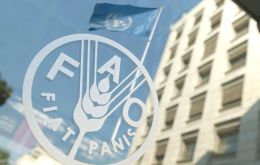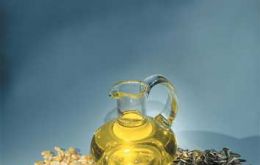MercoPress. South Atlantic News Agency
Tag: Food Price Index
-
Monday, June 9th 2014 - 06:27 UTC
FAO Food Price Index down for the second consecutive month in May

The FAO Food Price Index was down for the second consecutive month in May, continuing its retreat from the 10-month high it experienced in March. Prices fell as generally ample supplies weighed on international prices for most commodities included in the Index.
-
Saturday, May 10th 2014 - 00:05 UTC
Despite some setbacks, FAO expects second largest cereal production this year

Weather conditions in various countries and political tensions in the Black Sea region have made food markets more volatile, FAO reports in the new Food Outlook. In its first major forecast for 2014, FAO puts cereal production at 2 458 million tons (including milled rice), down some 2.4% from the 2013 record, though global output is still expected to be the second largest ever.
-
Friday, December 13th 2013 - 08:52 UTC
FAO food price index in November unchanged: dairy up 23% over a year ago

The FAO Food Price Index averaged 206.3 points in November 2013, almost unchanged from the revised value of 206.6 points in October, but 9.5 points (4.4%) below its November 2012 value. A sharp decline in sugar prices last month nearly offset the rise in oils. Cereals averaged slightly lower but meat and dairy values were stable.
-
Friday, September 6th 2013 - 00:57 UTC
FAO food price index drops for fourth month running; abundant cereal crops

FAO Food Price Index dropped for the fourth month in a row in August reaching its lowest level since June 2012. The index, which measures the monthly change in the international prices of a basket of food commodities, averaged 201.8 points in August 2013, nearly 4 points (1.9%) below its July value and 11 points (5.1% less than in August 2012.
-
Friday, November 9th 2012 - 06:27 UTC
FAO October Price Index: cereals and oils down; increases in dairy and sugar

The FAO Food Price Index fell 1% in October 2012, and for the first ten months of the year food prices were on average 8% lower than in the same period in 2011. The Index dipped two points to 213 points from September's revised level of 215 points. The decline was largely due to lower international prices of cereals and oils and fats, which more than offset increases in dairy and sugar prices.
-
Friday, August 10th 2012 - 07:35 UTC
FAO warns countries against a repeat of the 2007/08 food prices crisis

The world could face a food crisis of the kind seen in 2007/08 if countries restrict exports on concerns about a drought-fuelled grain price rally, the UN food agency FAO warned, after reporting a surge in global food prices in July.
-
Friday, July 6th 2012 - 01:55 UTC
FAO food price index down in June but rebound anticipated for July

FAO Food Price Index fell for the third consecutive month in June 2012, dipping 1.8% from May to its lowest level since September 2010. The four-point drop in June brought the index to 201 points from a revised level of 205 points in May 2012.
-
Saturday, June 9th 2012 - 02:41 UTC
FAO food price index fell by 4% in May on prospects of good cereal production

United Nation’s Food and Agriculture Organization (FAO) said global food prices dropped sharply in May due to generally favourable supplies, growing global economic uncertainties and a strengthening of the US dollar.
-
Friday, April 27th 2012 - 23:11 UTC
World Bank Food Price Watch jumped 8% in four months to March

Global food prices increased by 8% from December 2011 to March 2012 due to higher oil prices, adverse weather conditions, and Asia’s strong demand for food imports, according to the World Bank Group’s latest Food Price Watch.
-
Tuesday, April 3rd 2012 - 03:47 UTC
Food inflation in South America is higher than the average overall index

In the last two years inflation in Latin America has stabilized varying between 6% and 7%, according to the latest monthly report from the FAO (Food and Agriculture Organization) regional office.
